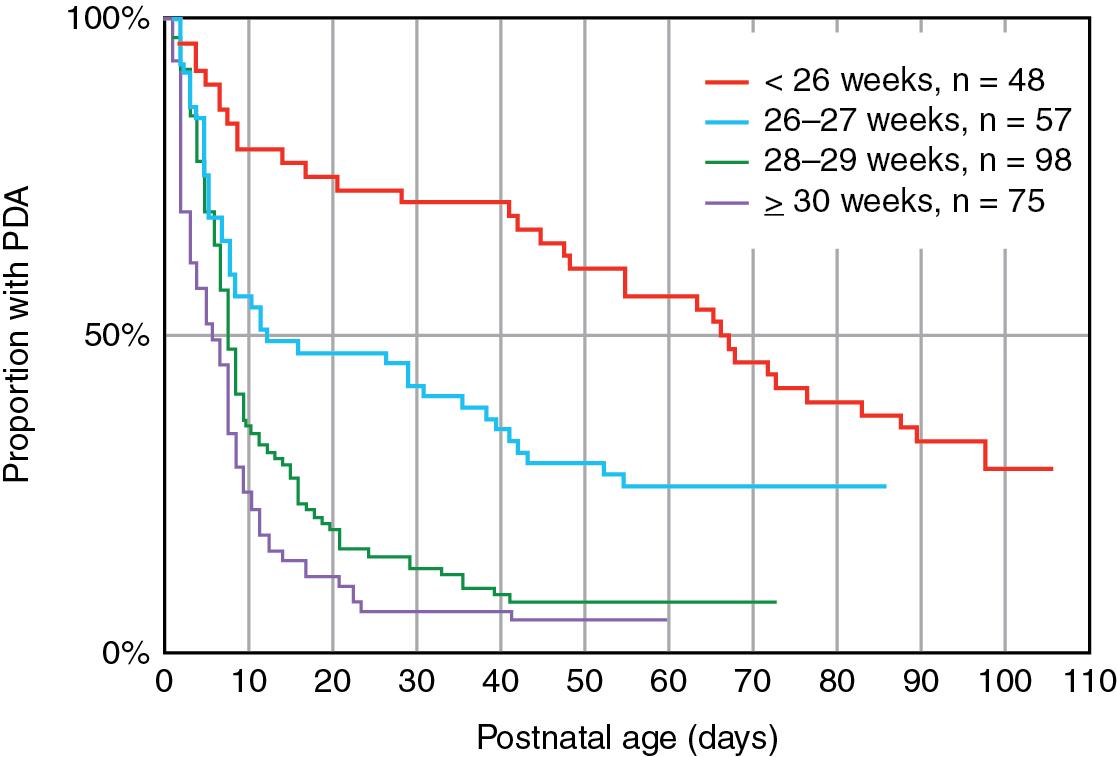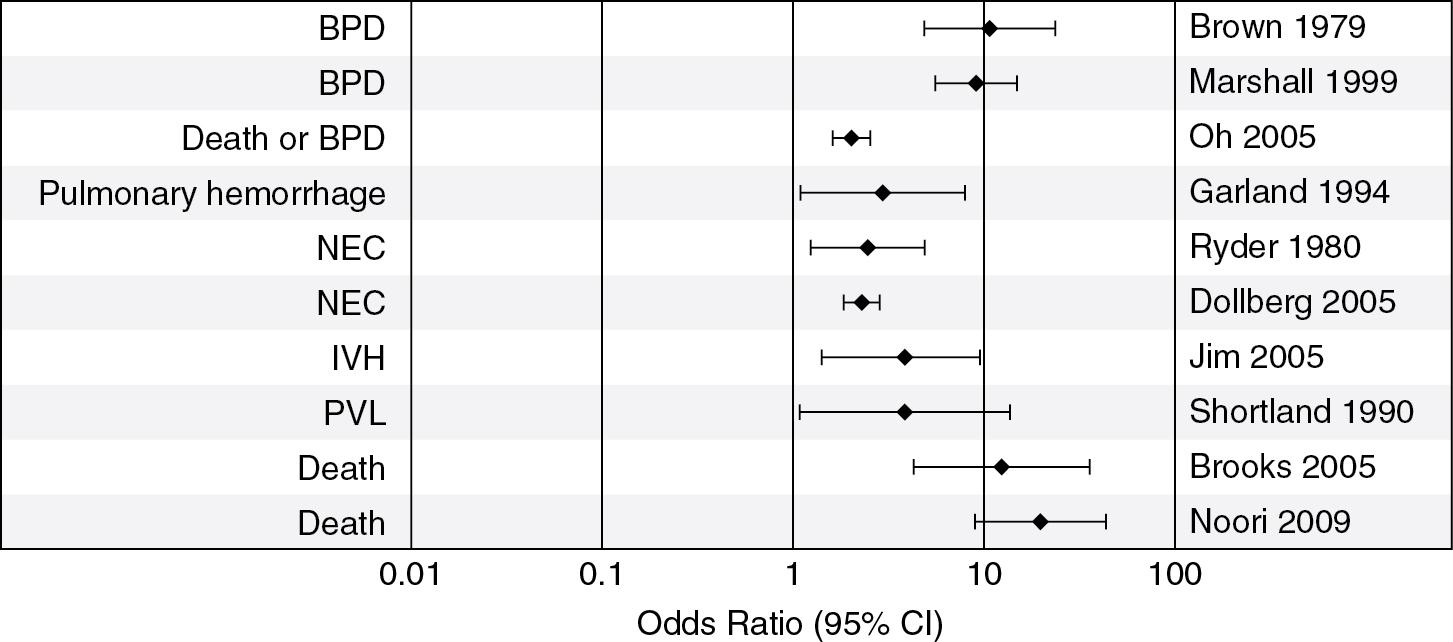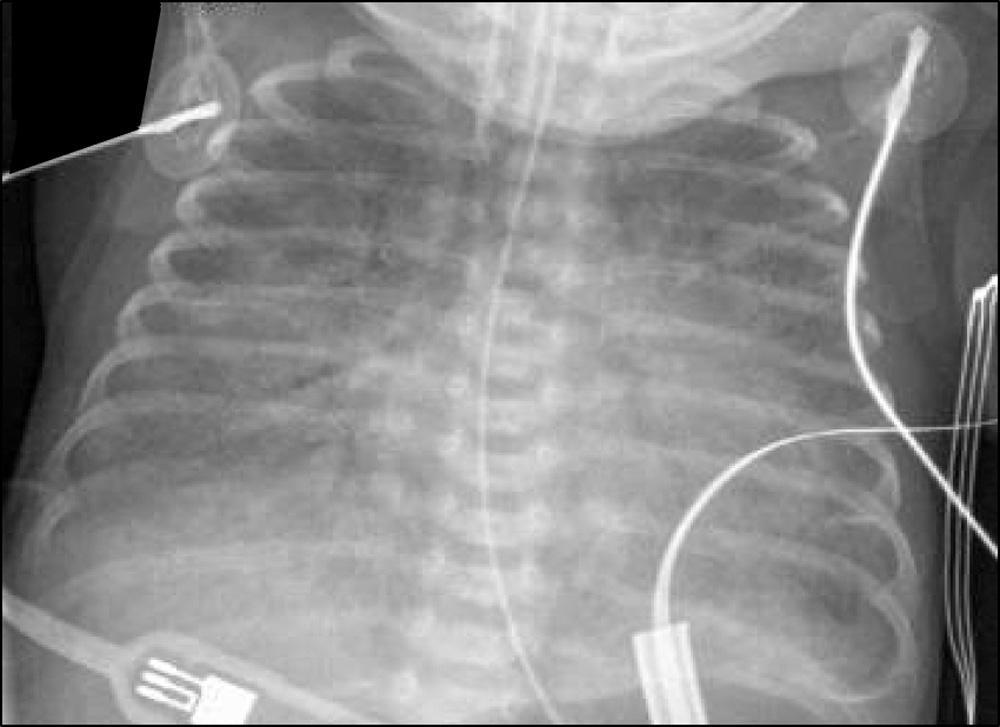Physical Address
304 North Cardinal St.
Dorchester Center, MA 02124
While the fetus remains in utero, the ductus arteriosus is an essential component of the circulation, permitting blood to flow right to left from the pulmonary artery to the descending aorta, bypassing the fluid-filled lungs and returning to the placenta for gas exchange. At birth, the low resistance placental circulation is removed, and pulmonary vascular resistance rapidly decreases, coincident with aeration of the lungs, resulting in reversal of ductal flow, which quickly becomes predominantly left to right, from the descending aorta into the pulmonary artery and onward to the lungs. Pulmonary blood flow therefore exceeds net systemic cardiac output until the ductus closes.
In term babies, the ductus normally constricts and becomes functionally occluded by the fourth postnatal day. If the ductus does not close, hemodynamic effects of a persistent left-to-right ductal shunt may become pathologic, potentially requiring active management. Persistent ductal patency for more than a few days in a term infant is usually associated with another significant underlying pathology, such as a syndromic condition or congenital heart disease, and almost always requires a surgical or cardiac catheterization intervention. In preterm infants, however, closure of the ductus is often substantially delayed and, in some instances, may not occur at all. Prolonged ductal patency in preterm infants is associated with increased risks for numerous adverse outcomes, but this relationship may not be causal. The best strategies for evaluation and treatment are not known, so these infants often pose very difficult management dilemmas. The case studies in this chapter will present some of these challenges and suggest strategies for addressing them.
An 840 g infant was delivered vaginally at 27 weeks’ gestation following spontaneous onset of preterm labor at 25 weeks. Her mother had been treated with indomethacin for tocolysis and magnesium sulfate for fetal neuroprotection. She had received two doses of betamethasone more than 24 hours before delivery. The baby was vigorous at birth and responded well to support with continuous positive airway pressure by nasal mask and supplemental oxygen at an Fi o 2 of 0.35.
Which of the following most accurately reflects the probability that this infant will have a patent ductus arteriosus (PDA) at 10 days of age, in the absence of interventions intended to close the ductus?
10%
20%
33%
60%
90%
Which of the following features of this baby’s perinatal history are associated with an increased risk of prolonged ductal patency?
Estimated gestational age (EGA) <28 weeks
Birth weight <1000 g
Prenatal exposure to indomethacin
Prenatal exposure to magnesium sulfate
Treatment with antenatal steroids
D
All except E
In most healthy infants born after 36 weeks’ gestation, the ductus constricts and becomes functionally closed by 72 hours of age and in all by 96 hours of age. The timing of ductal closure is related to maturity, with nearly all infants over 38 weeks’ gestation achieving closure by 48 hours of age but only 50% and 60% of those born at 36 to 38 weeks. Among preterm infants, rates of ductal patency and the postnatal age at ductal closure progressively increase with decreasing gestational age at birth ( Fig. 14.1 ). Because over half of infants born at 27 weeks still have a PDA on day 10 ( Fig. 14.1 ), the correct answer to Question 1 is D (60%).

Early observations suggested that spontaneous ductal closure could nearly always be expected given sufficient time, but this sometimes took several months ( ). However, changes in practice—including widespread use of treatments to close the ductus, antenatal steroids to induce lung maturity, exogenous surfactant to ameliorate respiratory distress syndrome (RDS), better strategies for respiratory support, and greatly increased survival rates among very low birth weight (VLBW) and extremely low birth weight (ELBW) infants—soon made application of those observations to practice untenable. More recent data show that the ductus closes without treatment even in preterm infants born before 28 weeks’ gestation ( ). Observational data from preterm infants under 1000 g with a persistent PDA at hospital discharge suggest that the PDA will close in about 75% ( ) by the end of the first year. These data demonstrate that spontaneous closure of the ductus should be expected in most preterm infants.
A number of perinatal factors, in addition to prematurity and low birth weight, influence the risk of prolonged ductal patency. PDA is more common among infants who are small for gestational age, exposed to indomethacin for tocolysis before delivery, or given magnesium sulfate for neuroprotection ( ), and less frequent after antenatal administration of glucocorticoids. The correct answer to Question 2 is therefore “All except E,” because that item (antenatal steroid exposure) is associated with a lower risk of PDA. A strong relationship between PDA and RDS has been recognized for many years. Although the causal nature of this association remains uncertain, PDA is consequently more common among infants who require ventilatory assistance or exogenous surfactant. This infant’s requirement for support with positive airway pressure and supplemental oxygen, presumably owing to RDS, is an additional risk factor for PDA, although any causal relationship remains uncertain. The spontaneous onset of preterm labor and failure of tocolytic therapy may be signs of an intrauterine bacterial infection, another factor that would predispose to persistent PDA ( ).
At 7 days of age, a large PDA is documented by echocardiography. Which of the following conditions are associated with persistent patency of the ductus arteriosus at age 7 days?
Pulmonary hemorrhage
Bronchopulmonary dysplasia
Necrotizing enterocolitis
Prolonged requirement for respiratory support
Intraventricular hemorrhage
Death
All except A
Delayed closure of the ductus arteriosus was first recognized more than 50 years ago as a common correlate of more severe respiratory distress in premature infants. It has subsequently been linked to numerous adverse outcomes, including prolonged ventilation, bronchopulmonary dysplasia (BPD), necrotizing enterocolitis (NEC), impaired renal function, intraventricular hemorrhage (IVH), periventricular leukomalacia (PVL), cerebral palsy, and death ( ). These complications are often attributed to a large left-to-right ductal shunt, resulting in excessive pulmonary perfusion and systemic organ ischemia, but the pathogenetic processes underlying these associations remain undetermined.
The strength of associations between PDA and adverse outcomes are quite impressive ( Fig. 14.2 ). A study at two Boston hospitals in 1978 demonstrated that PDA increased the odds of BPD more than tenfold (OR 10.7) ( ). A population-based study of preterm infants in North Carolina in 1994 found an odds ratio for BPD of 9.0 ( ), and a multicenter trial conducted between 1999 and 2001 reported an odds ratio for death or BPD of 2.0 ( ). Data collected at two Boston hospitals from 1989 to 1992 revealed that ductal patency at 12 to 18 hours of age was associated with an odds ratio for early, severe pulmonary hemorrhage of 3.0 ( ), but pulmonary hemorrhage after the first week was not related to persistent ductal patency. More recent data from the DETECT (Ductal Echocardiographic Targeting and Early Closure Trial) study suggest that large PDA (diameter >50th percentile for age) in the first 12 hours after birth is associated with pulmonary hemorrhage before 72 hours of age ( ). Early treatment reduced the rate of early pulmonary hemorrhage but not the rate of all pulmonary hemorrhages or other adverse outcomes.

A multicenter study from the late 1970s demonstrated an odds ratio for NEC of 2.5 in infants with a PDA ( ), and an Israeli national analysis of NEC cases from the late 1990s found an odds ratio of 2.3 ( ). The odds ratios for IVH ( ) and that for periventricular leukomalacia ( ) have both been estimated to be 3.9. Infants in whom the ductus remains open despite treatment with indomethacin are much more likely to die before hospital discharge than those whose ductus closes without treatment. In data from a single center in Western Australia, persistent PDA after treatment was associated with an odds ratio for neonatal death of 12.3 (versus infants with spontaneous closure); after adjustment for gestational age and severity of illness, the adjusted odds ratio was still 4.0 (95% CI 1.1–14.5) ( ). A similar analysis from Oklahoma found an unadjusted odds ratio of 19.3; adjustment for perinatal factors, level of maturity, disease severity, and morbid pathologies resulted in an adjusted odds ratio of 16.8 (95% CI 6.1–46.6) ( ). Confidence intervals for these odds ratios are shown in Fig. 14.2 ; all are statistically significant. Despite the magnitude of these associations, they do not prove a causal role for persistent ductal patency in production of those adverse outcomes. Nonetheless, these results (and others like them) have provided great impetus for the hypothesis that elimination of ductal patency might substantially improve long-term outcomes for preterm infants.
Which of the following physical findings on the tenth day after birth might suggest the diagnosis of persistent ductal patency?
Bounding radial arterial pulses
Palpable pulses in the palms of the hands
Pulsus paradoxus
Hyperdynamic precordium
Systolic murmur
Bilateral rales
Hepatomegaly
Cool extremities
Intermittent cyanotic episodes
Absent bowel sounds
Which of the following radiographic findings on the seventh day after birth might suggest the presence of a PDA?
Cortical hyperostosis of long bones
Cardiomegaly
Increased lung lucency
Prominent pulmonary vascular markings
Pulmonary edema with a small heart
Elevation of the left hemidiaphragm
Which of the following clinical conditions during the second week after birth might suggest the presence of a PDA?
Oliguria with increasing blood urea nitrogen (BUN) levels
Feeding intolerance
Central apnea episodes
Persistent jaundice
Inability to wean respiratory support
A, B, D, E, G, and H
B and D
A and E
Persistent ductal patency in a preterm infant may become evident through findings on physical examination or because of signs of circulatory or respiratory impairment. A persistent PDA may first become apparent from development of the characteristic coarse systolic murmur heard best along the left sternal border. However, many infants with a large PDA may have no audible murmur despite having a large left-to-right shunt and substantial pulmonary overcirculation. The murmur may become audible or increase in intensity only as the ductus constricts, resulting in higher velocity and more turbulent shunt flow. The increased left ventricular stroke volume imposed by a large left-to-right shunt may produce a prominent precordial impulse or hyperactive precordium. Arterial pulses often are prominent, bounding, or palpable where they normally are not (e.g., in the palms). Reduced systemic diastolic pressures with widened pulse pressures are common in preterm infants over 1000 g but lower systolic, diastolic, and mean arterial pressures without an increased pulse pressure are more typical in those under 1000 g. Congestive heart failure may be evident as rales, hepatomegaly, or peripheral edema. These findings are nonspecific, insensitive, and do not reliably predict echocardiography results ( ). Similar physical findings may be present in infants with other circulatory disorders, such as aortopulmonary window, hemitruncus, or arteriovenous malformations, or in hyperdynamic conditions, such as anemia, fever, or sepsis. Choices A, B, D, E, F, and G are correct answers to Question 1.
Pulsus paradoxus, or phasic decreases in systolic blood pressure in synchrony with respiration, should not accompany PDA. If that finding is observed in an infant with a large heart and signs of congestive heart failure, pericardial effusion and tamponade should be considered. The continuous “machinery” or “to-and-fro” murmur typical of PDA in older children is rarely found in neonates. The “runoff” effect of left-to-right ductal shunting into the pulmonary circulation is very rarely sufficient to result in overt signs of compromised systemic perfusion, such as cool extremities or lactic acidemia; such findings should suggest other causes of compromised systemic cardiac output, such as hypovolemia or sepsis. Cyanotic episodes associated with a PDA would imply periods of right-to-left shunting, which should not occur unless there is another pathologic abnormality, such as pulmonary edema, pulmonary hypertension, or compromised left ventricular output. Bowel ischemia is a potential adverse effect of the “ductal steal,” but experience has shown that feedings can be continued despite ductal patency ( ), so loss of bowel sounds would not be expected as a sign of a PDA. Choices C, H, I, and J are therefore not correct answers to Question 1.
PDA is frequently suspected only because excessive pulmonary blood flow leads to pulmonary edema, which results in increasing oxygen requirement, decreasing lung compliance, or inability to wean the infant from supplemental oxygen, distending airway pressure, or positive pressure ventilation. Systemic hemodynamic effects include hepatomegaly and peripheral edema, as well as signs of suboptimal organ perfusion. In particular, a large ductal shunt may compromise renal blood flow, resulting in oliguria and chemical signs of prerenal renal failure (rising BUN without a proportionate increase in serum creatinine). Because of these effects, B and D are correct answers to Question 2 and A and E are correct answers to Question 3.
Cortical hyperostosis may result from prolonged administration of prostaglandin E 1 (alprostadil) to maintain ductal patency of the ductus in infants with ductus-dependent congenital heart disease but does not result from ductal patency itself. Excessive pulmonary blood flow may lead to decreased, but not increased, radiolucency of the lungs, as shown in Fig. 14.3 , which also demonstrates cardiomegaly. A small heart in an infant with pulmonary edema should suggest capillary leak or pulmonary venous or lymphatic obstruction; PDA is unlikely to be the cause of the lung findings. Paralysis of the left hemidiaphragm may follow surgical ligation of the ductus but is rarely associated with a PDA alone. Although feeding intolerance has been proposed as a criterion for assessment of the hemodynamic significance of PDA ( ), a moderate PDA does not cause feeding intolerance or require discontinuation of feeding, as noted earlier. Feeding intolerance in an infant with PDA suggests a severe ductal steal resulting in either significant bowel ischemia or severe congestive heart failure with bowel edema; in either case, other clinical signs would be prominent. A PDA does not affect central nervous system or hepatic function, so central apnea or prolonged jaundice would not be expected associations. Items A, C, E, and F are therefore not correct answers to Question 2, and B, C, and D are not correct answers to Question 3.

Between 7 and 10 days of age, the infant described in Case Study 1 continues to require support with nasal continuous positive airway pressure (NCPAP) and exhibits a gradually increasing oxygen requirement. Her heart rate is 175 beats per minute and blood pressure is 35/18 (mean 26). She has a soft systolic murmur, full pulses, and her liver edge is palpable 2 cm below the right costal margin.
Become a Clinical Tree membership for Full access and enjoy Unlimited articles
If you are a member. Log in here